
246 CHAPTER 13. SOME FUNDAMENTALS∗
Definition 13.8.1 The symbol ∑∞k=1f k (x) means limn→∞ ∑
nk=1f k (x) provided this limit
exists. This is called pointwise convergence of the infinite sum. Thus the infinite sum meansthe limit of the sequence of partial sums. The infinite sum is said to converge uniformly ifthe sequence of paritial sums converges uniformly.
Note how this theorem includes the case of ∑∞k=1ak as a special case. Here the ak don’t
depend on x.The following theorem is very useful. It tells how to recognize that an infinite sum is
converging or converging uniformly. First is a little lemma which reviews standard calcu-lus.
Lemma 13.8.2 Suppose Mk ≥ 0 and ∑∞k=1 Mk converges. Then
limm→∞
∞
∑k=m
Mk = 0
Proof: By assumption, there is N such that if m≥ N, then if n > m,∣∣∣∣∣ n
∑k=1
Mk−m
∑k=1
Mk
∣∣∣∣∣= n
∑k=m+1
Mk < ε/2
Then letting n→ ∞, one can pass to a limit and conclude that∞
∑k=m+1
Mk < ε
It follows that for m > N,∑∞k=m Mk < ε . The part about passing to a limit follows from the
fact that n→ ∑nk=m+1 Mk is an increasing sequence which is bounded above by ∑
∞k=1 Mk.
Therefore, it converges by completeness of R. ■
Theorem 13.8.3 For x ∈ S, if ∑∞k=1 |f k (x)|< ∞, then ∑
∞k=1f k (x) converges pointwise. If
there exists Mk such that Mk ≥ |f k (x)| for all x∈ S, then ∑∞k=1f k (x) converges uniformly.
Proof: Let m < n. Then∣∣∣∣∣ n
∑k=1
f k (x)−m
∑k=1
f k (x)
∣∣∣∣∣≤ ∞
∑k=m|f k (x)|< ε/2
whenever m is large enough due to the assumption that ∑∞k=1 |f k (x)|< ∞. Thus the partial
sums are a Cauchy sequence and so the series converges pointwise.If Mk ≥ |f k (x)| for all x ∈ S, then for M large enough,∣∣∣∣∣ n
∑k=1
f k (x)−m
∑k=1
f k (x)
∣∣∣∣∣≤ ∞
∑k=m|f k (x)| ≤
∞
∑k=m
Mk < ε/2
Thus, taking sup ∥∥∥∥∥ n
∑k=1
f k (·)−m
∑k=1
f k (·)
∥∥∥∥∥≤ ε/2 < ε
and so the partial sums are uniformly Cauchy sequence. Hence they converge uniformly towhat is defined as ∑
∞k=1f k (x) for x ∈ S. ■
Some of the following exercises have been essentially done in the above discussion.Try doing them yourself. There are also some new topics.